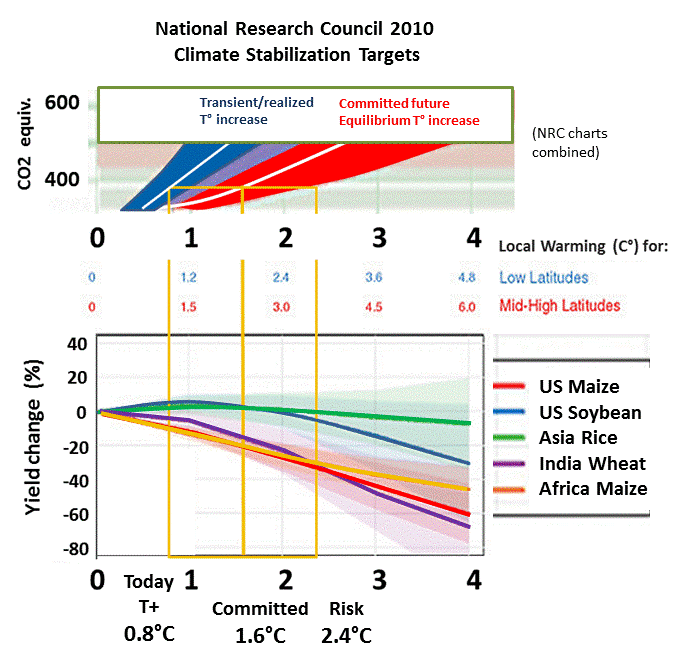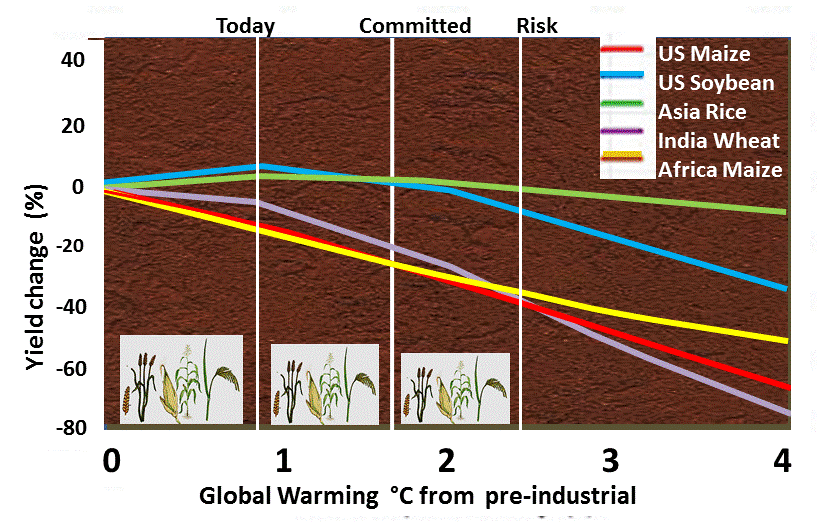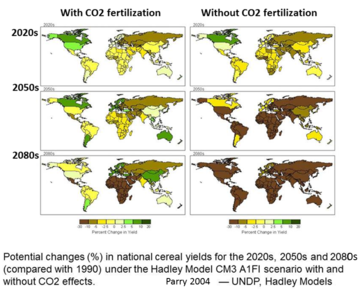
Climate Change and Food Security
Extreme weather events
Temperature
Obviously there is a temperature range within which the plants can optimally grow and reproduce. Growth and reproduction are less efficient at temperatures above this range. Above a certain temperature, the plants cannot reproduce.
The most critical responses are that crops develop more quickly under warmer temperatures, leading to shorter growing periods and lower yields, and that higher temperatures drive faster evaporation of water from soils and transpiration of water from crops.
Many important grain crops tend to have lower yields when summer temperatures increase, primarily because heat accelerates the plant’’s developmental cycle and reduces the duration of the grain-filling period (CCSP, 2008a; Rosenzweig and Hillel, 1998).
Exposure to extremely high temperatures (e.g., > 35C) can also cause damage in photosynthetic, reproductive, and other cells, and recent evidence suggests that even short exposures to high temperatures can be crucial for final yield (Schlenker and Roberts, 2009; Wassmann et al., 2009).
The commitment of increased climate change and increased damages to crops.
For food security for humanity (all future generations) there is another huge problem arising from the models and how their results are applied.
That problem is the lag effect of an increase in the atmospheric GHGs concentration and the full amount of global temperature increase caused by it.
This fundamental aspect of the climate science is not accounted for in policy considerations for estimating climate change danger.
At any particular time, in the situation of continuing greenhouse gas emissions, the global average temperature increase does not fully reflect the increased atmospheric GHG concentration at that time. The full amount of global temperature increase 'commitment' is double the temperature increase at that point in time. That committed additional global warming takes place over hundreds of years.
At any particular time, in the situation of continuing greenhouse gas emissions, the global average temperature increase does not fully reflect the increased atmospheric GHG concentration at that time. The full amount of global temperature increase 'commitment' is double the temperature increase at that point in time. That committed additional global warming takes place over hundreds of years.
Today's already absolute committed global average temperature increase from the ocean heat lag alone is 1.6° C. With the aerosol cooling factor it is 2.4°C up to 4°C

Extreme Weather Events
The Intergovernmental Panel on Climate Change (IPCC) classifies
extreme weather events as one category of climate change impacts.
As such, this category is the most damaging to both human population
health and to food productivity.
The IPCC AR5 WG1 chart of extreme weather and climate events shows the world is
in terrible trouble:
- All extremes have increased (since 1950)
- It is likely that climate change has contributed to these increases
- It is likely that they will increase more by 2035
- It is likely they will increase more by 2100.
Because we are already locked in (climate system inertia-momentum) to climate
change by 2035, a further large increase in disastrous to catastrophic
extreme weather impacts to human populations and crops is unavoidable.
In the most vulnerable developing regions where agriculture is labour
intensive extreme weather events deal a double blow of interacting
harm to human populations and their food supply.
The IPCC addresses the risk of impact severity with rising global
temperatures by a diagram 'Reasons for Concern', also known as
the burning embers of impacts
Note since the IPCC 2001 assessment to AR5 2014 the temperature thresholds
for a particular Reason for Concern has dropped markedly especially tipping points.
The Intergovernmental Panel on Climate Change (IPCC) classifies
extreme weather events as one category of climate change impacts.
As such, this category is the most damaging to both human population
health and to food productivity.
The IPCC AR5 WG1 chart of extreme weather and climate events shows the world is
in terrible trouble:
- All extremes have increased (since 1950)
- It is likely that climate change has contributed to these increases
- It is likely that they will increase more by 2035
- It is likely they will increase more by 2100.
Because we are already locked in (climate system inertia-momentum) to climate
change by 2035, a further large increase in disastrous to catastrophic
extreme weather impacts to human populations and crops is unavoidable.
In the most vulnerable developing regions where agriculture is labour
intensive extreme weather events deal a double blow of interacting
harm to human populations and their food supply.
The IPCC addresses the risk of impact severity with rising global
temperatures by a diagram 'Reasons for Concern', also known as
the burning embers of impacts
Note since the IPCC 2001 assessment to AR5 2014 the temperature thresholds
for a particular Reason for Concern has dropped markedly especially tipping points.
The 'extreme weather events' category includes:
Research has linked increases in all of these extreme events with global climate change.
It has been known since the 1995 second IPCC assessment that global warming would increase severe weather events.potentially serious changes have been identified, including an increase in some regions in the incidence of extreme high-temperature events, floods, and droughts, IPCC 1995 SARExtreme weather events have always happened. Global climate change increases the frequency and severity of every king of severe weather event. The type, frequency and intensity of extreme events are expected to change as Earth’s climate changes, and these changes could occur even with relatively small mean climate changes. Changes in some types of extreme events have already been observed, for example, increases in the frequency and intensity of heat waves and heavy precipitation events. (IPCC 2007) The reason for this is that more atmospheric greenhouse gases increases: o the lower atmosphere temperature
o lower atmosphere energ lower atmosphere water vapour (warmer air holds morre water vapour)
- Heat stress and unusually hot days that can damage a whole crop
- Heat waves
- Droughts
- Forest fires (can burn crops)
- Severe storms
- Torrential rain
- Floods
- Hurricanes (Atlantic) and tropical cyclones
- Extreme high sea levels
Climate change causes these events to increase in frequency and or severity.
These all damage crops.
Research has linked increases in all of these extreme events with global climate change.
It has been known since the 1995 second IPCC assessment that global warming would increase severe weather events.potentially serious changes have been identified, including an increase in some regions in the incidence of extreme high-temperature events, floods, and droughts, IPCC 1995 SARExtreme weather events have always happened. Global climate change increases the frequency and severity of every king of severe weather event. The type, frequency and intensity of extreme events are expected to change as Earth’s climate changes, and these changes could occur even with relatively small mean climate changes. Changes in some types of extreme events have already been observed, for example, increases in the frequency and intensity of heat waves and heavy precipitation events. (IPCC 2007) The reason for this is that more atmospheric greenhouse gases increases: o the lower atmosphere temperature
o lower atmosphere energ lower atmosphere water vapour (warmer air holds morre water vapour)
-
Therefore Increased heat waves and droughts are the result of global warming.
Even with increased water vapour in the atmosphere the heat can be enough to dry out the affected region.
The increased storms and floods are the result of increased water vapour in the air (warm air can contain more water) plus the increased energy in the lower atmosphere (heat is energy).
All of the above can cause crop damage and also soil erosion and land degradation.
Extreme weather events are already increasing due to global warming (IPCC 2007) and will increase further (IPCC special report 2012)..
There are now several studies published demonstating that the global and Northern hemisphere increase in extreme weather has damaged criops (specefic extreme events) and the severity of the extreme event even would not have happened with the driving influence of global warming.
There is research inidcating that the increasing extreme Northenr hemisphere weather events are being driven by rapidly declining Arctic sproing-summer albedo cooling.
However, the climate change assessment models do not capture the real impact of extreme weather events and so they are not accounted for in the climate crop yield production changes of the IPCC assessment.
Climate change caused increase in extreme weather events has already started and at today's at 0.8C increase in the global temperature.
The temperature increase commitment commits us in a few decades to damaging impacts to agriculture in all regions.
Extreme weather events increase with global temperature increase - in all regions. The 'burning embers' illustration is how the scientists expect extreme weather events to increase.
Today's global average temperature increase is O.8° C.
Today's absolute temperature increase commitment is 1.6° C due to the heat lag from the oceans.
The illustration opposite shows this situation of climate change commitment to reductions of crop yields.
Most scientists say we already committed to an increase of above 2°C.
Recent publisihed science puts our commitment today as high as 2.4° C (Ramanthan, Feng PNAS 2008).
So if a policy maker wanted to avoid exposing all the agriculture of future generations to a global average temperature increase of 2°C (for example), calculating this from the climate crop model results for 2°C will not work for the food security of all future generations.
The policy will have to be based on preventing a temperature increase of 1.0°C.
The policy will have to be based on preventing a temperature increase of 1.0°C.
This is not being considered.
The graph opposite is constructed by combining the NRC committed temperature increases (future) at transient or realized temperature increase (today) with the NRC model projected crop yield changes with temperature, CO2 and moisture changes. (NRC Climate Stabilization Targets 2010)



Europe heat wave drought 2003 crop losses IPCC
2010 N Hemisphere & record Russia heat wave, wild fires, crop losses .
New research
Sept 2014 OXFAM Extreme weather- extreme food prices warming world
Oct 2013 Nature
Robust twenty-first-century projections of El Niño and related precipitation variability _ more extreme drought and floods
Sept 2014 OXFAM Extreme weather- extreme food prices warming world
Oct 2013 Nature
Robust twenty-first-century projections of El Niño and related precipitation variability _ more extreme drought and floods

